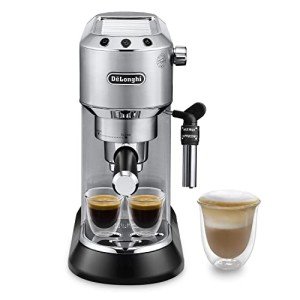This Week's Top Stories Concerning Italian Espresso Machines
Heat Exchange Espresso Machines: A Comprehensive Guide
Espresso machines have evolved significantly throughout the years, catering to the needs of home baristas and coffee specialists alike. Among these machines, heat exchange espresso machines have actually gotten appeal due to their ability to deliver consistent efficiency and exceptional brew quality. In this article, we will check out the workings, advantages, and crucial features of heat exchange espresso machines, supplying a comprehensive understanding for both possible buyers and coffee lovers.
Comprehending Heat Exchange Technology
Heat exchange espresso machines run on a special principle that allows synchronised water heating for brewing and steaming. They are equipped with a single boiler that uses a heat exchanger system. This feature is significant as it enables users to brew espresso while steaming milk concurrently, promoting efficiency in the coffee-making process.
How Does a Heat Exchange Espresso Machine Work?
The procedure begins with the machine's water inlet filling the boiler. As the water warms up, it turns to steam. The ingenious heat exchanger uses hot steam to heat additional water in a different passage created particularly for the brew group. This means that water can reach the perfect brewing temperature without waiting on the boiler to adjust. The key steps include:
- Water Fill: Water is drawn into the boiler.
- Heating Process: The boiler heats up as water is transformed into steam.
- Heat Exchange: Steam warms water in the heat exchanger tube.
- Brewing: Water from the heat exchanger is pressed through coffee premises, drawing out the tastes required for an abundant espresso.
This process permits for fast temperature modifications and improved coffee extraction.
Advantages of Heat Exchange Espresso Machines
Heat exchange espresso machines provide several advantages, especially for those looking to maximize their coffee experience. Here are some key benefits:
- Simultaneous Brewing and Steaming: Users can brew espresso while steaming milk, making it ideal for busy cafes and home baristas who value effectiveness.
- Temperature level Stability: The boiler's steam pressure helps preserve a steady temperature, which is vital for consistent espresso extraction.
- Versatility: The design enables for fast changing between brewing and steaming, making it easier to produce various coffee drinks, from lattes to cappuccinos.
- Easy to use: Models typically include accessible controls, making it feasible for both beginners and skilled baristas to produce quality drinks.
- Professional Quality: Heat exchange machines are typically utilized in commercial settings, offering users with high-quality developing performance in the house.
Key Features to Look for in Heat Exchange Espresso Machines
When considering the purchase of a heat exchange espresso machine, there are numerous features that one must consider:
- Build Quality: Look for machines made from resilient products, such as stainless steel or brass, guaranteeing durability.
- Boiler Size: A larger boiler will hold more water and sustain greater output gradually.
- PID Temperature Control: This feature assists preserve constant brew temperature levels, which can enhance the coffee-making process.
- Group Head Design: Machines with a saturated or semi-saturated group head provide much better temperature stability.
- Ease of Use: User-friendly interfaces and instinctive controls enhance the general experience for baristas at all skill levels.
- Steam Wand Quality: A good steam wand with correct insulation and flexibility allows for much better texturing of milk.
- Water Reservoir Size: Depending on your needs, think about how frequently you desire to fill up the water reservoir.
Contrast of Popular Heat Exchange Espresso Machines
To better comprehend the alternatives available in the market, below is a contrast table of some popular heat exchange espresso machines:
Machine Model
Boiler Size
PID Control
Cost Range
User Ratings
Profitec Pro 700
2.0 L
Yes
₤ 2,000-₤ 2,500
9.5/ 10
Rocket Espresso R58
1.8 L
Yes
₤ 2,400-₤ 2,800
9.4/ 10
Elekta Bianca
1.8 L
Yes
₤ 2,500-₤ 3,000
9.6/ 10
La Spaziale S1 Vivaldi II
1.5 L
Yes
₤ 1,800-₤ 2,200
9.2/ 10
Bezzera Magica
1.2 L
No
₤ 1,600-₤ 1,800
9.0/ 10
FAQs About Heat Exchange Espresso Machines
What is the primary distinction in between a heat exchange and a dual boiler espresso machine?
While both types can brew espresso and steam milk at the very same time, dual boiler machines have different boilers for brewing and steaming. On the other hand, heat exchange machines use a single boiler and a heat exchanger to attain the same function.
Are heat exchange machines suitable for novices?
Yes! Lots of heat exchange machines are developed with user-friendly functions, making them available for novices. With proper assistance and practice, users can quickly produce quality espresso.
What sort of maintenance do heat exchange espresso machines need?
Routine upkeep consists of descaling, cleaning up the boiler, checking seals and gaskets, and keeping the group head clean. Routine upkeep ensures durability and constant efficiency.
Can I use a heat exchange machine for various types of coffee beverages?
Absolutely! Heat exchange machines allow users to produce a variety of coffee drinks, consisting of espresso, lattes, cappuccinos, and more.
Heat exchange espresso machines represent a mix of development and custom, offering coffee enthusiasts with the tools required for crafting the best cup. Their ability to concurrently brew and steam, integrated with exact temperature control, makes them a compelling option for both home baristas and experts. With Manual Espresso Machines on functions and maintenance, users can open a world of beautiful coffee experiences, ensuring that each sip is as wonderful as the last.
